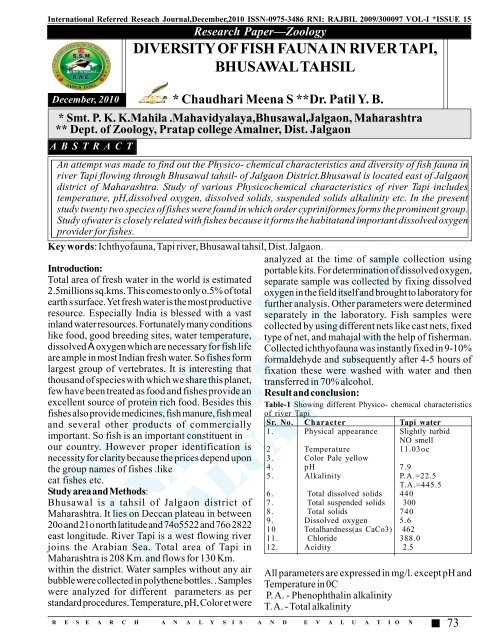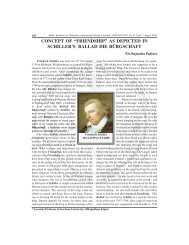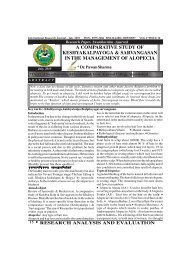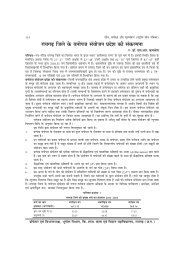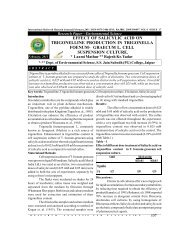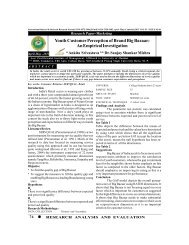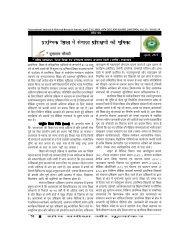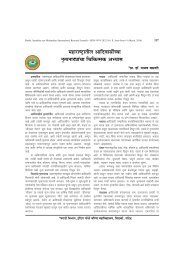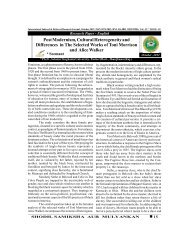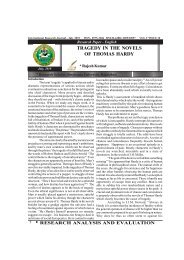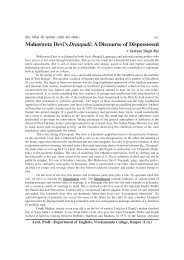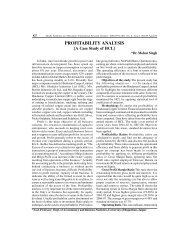research analysis and evaluation - international indexed refereed ...
research analysis and evaluation - international indexed refereed ...
research analysis and evaluation - international indexed refereed ...
Create successful ePaper yourself
Turn your PDF publications into a flip-book with our unique Google optimized e-Paper software.
International Referred Reseach Journal,December,2010 ISSN-0975-3486 RNI: RAJBIL 2009/300097 VOL-I *ISSUE 15<br />
Introduction:<br />
Total area of fresh water in the world is estimated<br />
2.5millions sq.kms. This comes to only o.5% of total<br />
earth s surface. Yet fresh water is the most productive<br />
resource. Especially India is blessed with a vast<br />
inl<strong>and</strong> water resources. Fortunately many conditions<br />
like food, good breeding sites, water temperature,<br />
dissolved A oxygen which are necessary for fish life<br />
are ample in most Indian fresh water. So fishes form<br />
largest group of vertebrates. It is interesting that<br />
thous<strong>and</strong> of species with which we share this planet,<br />
few have been treated as food <strong>and</strong> fishes provide an<br />
excellent source of protein rich food. Besides this<br />
fishes also provide medicines, fish manure, fish meal<br />
<strong>and</strong> several other products of commercially<br />
important. So fish is an important constituent in<br />
our country. However proper identification is<br />
necessity for clarity because the prices depend upon<br />
the group names of fishes .like<br />
cat fishes etc.<br />
Study area <strong>and</strong> Methods:<br />
Bhusawal is a tahsil of Jalgaon district of<br />
Maharashtra. It lies on Deccan plateau in between<br />
20o <strong>and</strong> 21o north latitude <strong>and</strong> 74o5522 <strong>and</strong> 76o 2822<br />
east longitude. River Tapi is a west flowing river<br />
joins the Arabian Sea. Total area of Tapi in<br />
Maharashtra is 208 Km. <strong>and</strong> flows for 130 Km.<br />
within the district. Water samples without any air<br />
bubble were collected in polythene bottles. . Samples<br />
were analyzed for different parameters as per<br />
st<strong>and</strong>ard procedures. Temperature, pH, Color et were<br />
Research Paper—Zoology<br />
DIVERSITY OF FISH FAUNA IN RIVER TAPI,<br />
BHUSAWAL TAHSIL<br />
December, 2010 * Chaudhari Meena S **Dr. Patil Y. B.<br />
* Smt. P. K. K.Mahila .Mahavidyalaya,Bhusawal,Jalgaon, Maharashtra<br />
** Dept. of Zoology, Pratap college Amalner, Dist. Jalgaon<br />
A B S T R A C T<br />
An attempt was made to find out the Physico- chemical characteristics <strong>and</strong> diversity of fish fauna in<br />
river Tapi flowing through Bhusawal tahsil- of Jalgaon District.Bhusawal is located east of Jalgaon<br />
district of Maharashtra. Study of various Physicochemical characteristics of river Tapi includes<br />
temperature, pH,dissolved oxygen, dissolved solids, suspended solids alkalinity etc. In the present<br />
study twenty two species of fishes were found in which order cypriniformes forms the prominent group.<br />
Study ofwater is closely related with fishes because it forms the habitat<strong>and</strong> important dissolved oxygen<br />
provider for fishes.<br />
Key words: Ichthyofauna, Tapi river, Bhusawal tahsil, Dist. Jalgaon.<br />
analyzed at the time of sample collection using<br />
portable kits. For determination of dissolved oxygen,<br />
separate sample was collected by fixing dissolved<br />
oxygen in the field itself <strong>and</strong> brought to laboratory for<br />
further <strong>analysis</strong>. Other parameters were determined<br />
separately in the laboratory. Fish samples were<br />
collected by using different nets like cast nets, fixed<br />
type of net, <strong>and</strong> mahajal with the help of fisherman.<br />
Collected ichthyofauna was instantly fixed in 9-10%<br />
formaldehyde <strong>and</strong> subsequently after 4-5 hours of<br />
fixation these were washed with water <strong>and</strong> then<br />
transferred in 70% alcohol.<br />
Result <strong>and</strong> conclusion:<br />
Table-1 Showing different Physico- chemical characteristics<br />
of river Tapi<br />
Sr. No. Character Tapi water<br />
1. Physical appearance Slightly turbid<br />
NO smell<br />
2 Temperature 11.03oc<br />
3. Color Pale yellow<br />
4. pH 7.9<br />
5. Alkalinity P.A.=22.5<br />
T.A.=445.5<br />
RESEARCH<br />
ANALYSIS AND<br />
EVALUATION<br />
6. Total dissolved solids 440<br />
7. Total suspended solids 300<br />
8. Total solids 740<br />
9. Dissolved oxygen 5.6<br />
10 Totalhardness(as CaCo3) 462<br />
11. Chloride 388.0<br />
12. Acidity 2.5<br />
All parameters are expressed in mg/l. except pH <strong>and</strong><br />
Temperature in 0C<br />
P. A. - Phenophthalin alkalinity<br />
T. A. - Total alkalinity<br />
R E S E A R C H A N A L Y S I S A N D E V A L U A T I O N<br />
73
International Referred Reseach Journal,December,2010 ISSN-0975-3486 RNI: RAJBIL 2009/300097 VOL-I *ISSUE 15<br />
Table-2 Ichthyofauna of river Tapi at Bhusawal tahsil<br />
Superclass –Pisces<br />
Class- Osteichthyes<br />
Infraclass- Teleostei<br />
Order: Cypriniformes<br />
[I] Family: Cyprinidae<br />
Subfamily: Cyprininae<br />
1. Labeo boggut (Sykes)<br />
2. Labeo calabasu (Ham-Buch.)<br />
3. Labeo fimbriatus(Bloch.)<br />
4. Tor khudree(Sykes)<br />
5. Osteobrama cotio cotio (Ham-Buch.)<br />
6. Osteobrama vigorssi (Sykes)<br />
7. Puntius conchonius (Ham-Buch.)<br />
8. Puntius ticto (Ham-Buch.)<br />
9. Puntius sophore (Ham-Buch.)<br />
10. Cirrhinus reba (Ham-Buch.)<br />
Subfamily: Cultrinae<br />
11. Salmostoma untrahi(Day)<br />
Order: Siluriformes<br />
[II] Family Bagridae<br />
12. Mystus bleekeri(Day)<br />
Study of Physico- chemical characteristics showed<br />
that low temperature <strong>and</strong> high aeration in Tapi river<br />
water is responsible for increased amount of<br />
Dissolved oxygen, which is essential for fish<br />
life.deficiency of dissolved water gives bad odor to<br />
water due to anaerobic decomposition of organic<br />
matter. TDS less than 1000 is nonsaline <strong>and</strong> also<br />
suitable for fish growth. river has pH 7.9 which is<br />
favourable for fish growth because pH less than 5.5<br />
to 6.5 is not suitable for fish growth. Ichthyofauna of<br />
Tapi river water constitutes 22 species under 15 genera<br />
belonging to 9 families <strong>and</strong> 6 orders. Order<br />
Cypriniformes forms predominant group. Carps are<br />
represented by Tor khudree Labeo calabasu, Labeo<br />
R E F E R E N C E<br />
13. Mystus oculatus (Valenciennes)<br />
14. Rita pavimentata (Valenciennes)<br />
Order :Perciformes<br />
[III]Family:Gobiidae<br />
15. Glossogobius giuris (Ham-Buch.)<br />
[IV] Family: Ambassidae<br />
16. Ch<strong>and</strong>a nama (Ham-Buch.)<br />
[V]Family:Notopteridae<br />
17. Notopterus notopterus (Pallas)<br />
VI]Family: Siluridae<br />
18. Ompok bimaculatus(Bloch)<br />
Order: Atheriniformes<br />
[VII] Family: Belonidae<br />
19. Xenentodon cancila (Ham-Buch.)<br />
Order: Channiformes<br />
[VIII]Family: Channidae<br />
20. Channa marulius (Ham-Buch.)<br />
Order: Synbranchiformes<br />
[IX] Family: Mastacembelidae<br />
21. Mastacembelusa. Armatus (Lacepede)<br />
22. Mastacembelusa pancalus (Ham-Buch.)<br />
fimbriatus etc. Cat fishes by Mystus bleekeri Mystus<br />
oculatus while perches by Glossogobius giuris <strong>and</strong><br />
Ch<strong>and</strong>a nama species. Study of status of<br />
ichthyofauna shows that among 22 species of fishes<br />
9 are common, 4 are declining, 3 are threatened, 4 are<br />
rare 1 endangered while 1 are restricted.<br />
Acknowledgements:-<br />
Authors are thankful to Principal Dr. S. R. Chaudhari<br />
Principal Pratap college, Amalner <strong>and</strong> Dr. A. M.<br />
Agrawal Principal Smt. P. K. K. Mahila Mahavidyalaya<br />
Bhusawal for providing laboratory facilities <strong>and</strong> also<br />
to <strong>research</strong>ers in Zoological survey of India, Pune, for<br />
providing their h<strong>and</strong>s of co-operation in identifying<br />
the fish species.<br />
RESEARCH<br />
ANALYSIS AND<br />
EVALUATION<br />
1) Arora M.G. <strong>and</strong> Singh M. 1994. Industrial Chemistry, Anmol Publication Pvt. Ltd. New Delhi 2) Beaven CAPT. R. A<br />
h<strong>and</strong> book of fresh water fishes of India. 3) Bhamrah H. S. Juneja Kavita 2001 An introduction of fishes Anmol Publication<br />
Pvt. Ltd. New Delhi 4) Hamilton- Buchanan 1882 An account on the fishes found in river Ganges <strong>and</strong> its branches ; edinburg<br />
& London : vii+ 405+ 39 pls. 5) Jayaram K.C. 2002. Fundamentals of Fish Taxonomy, Narendra Publishing House, Delhi.<br />
6) Menon A.G. K. 1999. Checklist Freshwater Fishes of India, Rec. zool. Surv. India 7) Sharma K.K,2004 Chief Complier,<br />
Intellectual2 s S<strong>and</strong>arbh Maharashtra State <strong>and</strong> District at a glance (2004) Vol.II, Publication, Intellectual book bureau<br />
Bhopal 8) Srivastav C.B.L., 1999. A text book of Fishery science <strong>and</strong> Indian Fishery Kitab Mahal Publication. 9) Yadav<br />
, B. E.2005 Fauna ofGoastate fauna series , Fresh water fishes, Zoological Survey of India, Pune. 2008<br />
74<br />
R E S E A R C H A N A L Y S I S A N D E V A L U A T I O N


